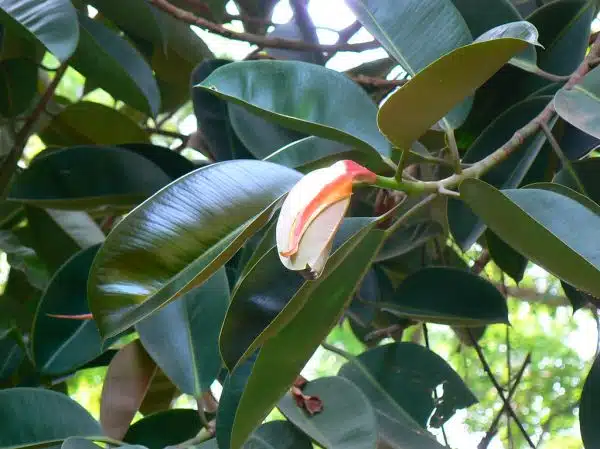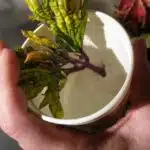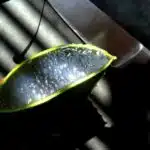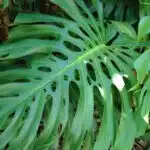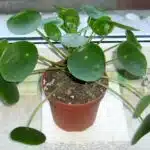Rubber trees (Ficus elastica) are a popular houseplant, known for their glossy leaves and easy care. As they grow, they can become quite large and unwieldy, making them difficult to move or repot. One solution to this problem is to propagate the rubber tree from cuttings, which allows you to create new plants that are smaller and easier to manage.
Propagating rubber trees from cuttings is a simple process that can be done with just a few basic tools and materials. With the right technique and a little patience, you can successfully create new plants that will thrive in your home or garden. In this article, we will explore the steps involved in propagating rubber trees from cuttings, including when and how to take the cuttings, how to prepare them for rooting, and how to care for the new plants once they have been established. Whether you are an experienced gardener or just starting out with houseplants, learning how to propagate rubber trees can be a rewarding experience that allows you to share your love of plants with others.
Understanding Rubber Tree Propagation
As the old saying goes, “You can’t make an omelette without breaking eggs.” Similarly, you cannot create a new rubber tree without propagating it. Propagation is the process of creating new plants from existing ones, and it is an essential part of horticulture. Rubber trees are no exception to this rule, and they can be propagated easily through cuttings.
Benefits of rubber tree propagation are numerous. Firstly, it helps to maintain plant genetics and ensure that desirable traits are preserved. Secondly, it is a cost-effective way to produce new plants in large numbers. Thirdly, propagating rubber trees from cuttings allows for the creation of exact replicas of parent plants that have desirable characteristics such as disease resistance or high yield.
Tips for successful propagation techniques include using healthy, disease-free parent plants, selecting appropriate cutting tools and taking care to make clean cuts at a 45-degree angle. It is also important to remove any leaves or branches from the lower portion of the cutting before planting it into moist soil or rooting hormone.
Choosing the right time and place for taking cuttings is crucial for success in propagating rubber trees. In the following section, we will discuss how to identify when and where to take cuttings.
Choosing The Right Time And Place For Taking Cuttings
The success of propagating rubber trees from cuttings relies heavily on the timing and location of the cutting process. Gardeners must choose the best locations for taking cuttings, as this will determine the quality and vigor of the new plants. The ideal location should be free from extreme temperatures, wind, or direct sunlight.
Optimal timing is also crucial in ensuring successful propagation. In general, it is best to take cuttings during the early spring when plants are actively growing. This ensures that the parent plant has enough energy reserves to support the growth of new roots and shoots. Additionally, gardeners must consider weather patterns when choosing a time to take cuttings. High humidity levels can help increase rooting success rates.
By selecting the right time and place for taking rubber tree cuttings, gardeners can improve their chances of success in propagation. However, these factors alone do not guarantee success. Gardeners must also ensure that they select healthy plant material for cutting. By carefully examining each plant before taking cuttings, gardeners can ensure that they are using only high-quality specimens capable of producing healthy offspring.
Selecting Healthy Plant Material
When propagating rubber trees from cuttings, the first step is to select healthy plant material. This is crucial for ensuring that the new plants will grow strong and produce good-quality rubber. To do this, it is important to observe the plant carefully and look out for any signs of damage or disease.
Pruning techniques are often used to help maintain healthy plants. When selecting plant material for propagation, it is important to choose branches that have been pruned properly. This means looking for branches that have been cut cleanly and at an appropriate angle. It is also important to avoid using branches that have been damaged by pruning or other causes, as these may be more susceptible to disease.
Common diseases such as leaf spot and crown rot can affect rubber trees and reduce their ability to produce good-quality rubber. To avoid propagating diseased plants, it is important to select healthy plant material from a reputable source. If you notice any signs of disease on your rubber tree, such as yellowing leaves or brown spots on the stems, it is best to remove the affected parts immediately and dispose of them properly. By taking these precautions when selecting plant material for propagation, you can ensure that your new plants will grow strong and healthy.
As you prepare to propagate your rubber trees from cuttings, it is also important to gather all the necessary tools and materials. These include rooting hormone, clean pruning shears, sterilized pots with drainage holes, a well-draining potting mix, and a misting system or plastic bag for maintaining humidity levels around the cuttings. With these tools in hand and healthy plant material selected, you are now ready to move onto the next step in propagating your own rubber trees from cuttings.
Preparing Your Tools And Materials
Before starting the propagation process, it is important to prepare your tools and materials. This will ensure that you have everything you need on hand and that they are clean and ready for use. Cleaning your tools is a crucial step, as dirty or contaminated tools can spread diseases or pests to the rubber tree cuttings, resulting in poor growth or even death.
To begin, gather all the necessary tools and materials for propagating rubber trees from cuttings. These include pruning shears or a sharp knife, rooting hormone powder, small pots filled with potting soil, and a spray bottle filled with water. It is best to source high-quality materials to ensure successful propagation. The rooting hormone powder should be fresh and potent, while the potting soil should be well-draining and nutrient-rich.
Next, clean your tools before using them. Use rubbing alcohol or a mixture of one part bleach to nine parts water to disinfect your pruning shears or knife. This will help prevent the spread of diseases between rubber tree cuttings. Once your tools are clean, allow them to air dry completely before use. By taking these steps, you can prepare yourself for propagating rubber trees from cuttings in a safe and effective manner.
As you prepare your tools and materials for propagating rubber trees from cuttings, remember that cleanliness is key to success. Be sure to source high-quality materials and clean your tools thoroughly before use. With these preparations complete, you can move on to making the cut without worrying about contamination or poor results due to inadequate preparation.
Making The Cut
When choosing the cutting for propagation, the best results will be achieved when selecting a healthy and vigorous branch with several nodes and a diameter of at least 10mm.
Once the desired cutting has been chosen, it should be cut at a 45-degree angle, just below a node.
To prepare the cutting, the leaves should be trimmed to two-thirds of their original size, and the bottom two-thirds of the cutting should be dipped in a rooting hormone.
Finally, the cutting should be inserted into a medium such as peat moss, which should be kept moist until roots have developed.
Choosing The Cutting
The first step in propagating rubber trees from cuttings is to choose the right cutting. This decision can greatly affect the success of your propagation efforts. To start, one should consider the cutting length and stem thickness. A general rule of thumb is to choose a cutting that is at least six inches long with a stem thickness around 1/4 inch.
When selecting a cutting, it’s important to look for healthy growth with no signs of damage or disease. The ideal branch for cutting would be from the top of the plant as it receives more sunlight and produces better quality cuttings. It’s also important to ensure that the cutting has at least two leaves attached as this will help provide energy for new roots to form.
One should also take into account the time of year when taking a cutting. Winter months can be more challenging due to lower temperatures and less light which can slow down root development. In contrast, taking cuttings during spring or summer months can be more advantageous as plants are actively growing and producing new growth. By carefully selecting and preparing your cuttings, you can greatly improve your chances of successful rubber tree propagation.
Preparing The Cutting
As a horticulturalist or plant propagation specialist, preparing the cutting is an essential step in propagating rubber trees successfully. Before making the cut, it’s crucial to ensure that all the tools are sterilized to prevent any potential disease or infection. It’s recommended to use sharp and clean pruning shears or a knife to make a clean cut.
After selecting the right cutting, the next step is to prepare it for rooting. This process involves removing any leaves from the bottom half of the cutting as they can take up energy that should be used for root development. Identifying nodes on the stem is also important as they are responsible for developing new roots and shoots. Applying rooting hormone to the cut end can help promote root growth.
Once prepared, insert the cutting into a well-draining soil mix, ensuring that at least 1-2 inches of stem is below the soil surface. Proper care and attention must be given throughout propagation by ensuring that adequate moisture levels are maintained while avoiding overwatering. By following these steps and incorporating best practices such as using rooting hormone and sterilizing tools, one can increase their chances of successful rubber tree propagation.
Preparing Cuttings For Rooting
Cutting care is an essential aspect of propagating rubber trees. Once the cuttings have been taken, they should be trimmed to remove any leaves that are close to the bottom. The remaining leaves should be cut in half to reduce water loss through transpiration. The cutting’s lower end should then be dipped into rooting hormones before being placed in a container filled with moist soil.
Rooting hormones are vital when propagating rubber trees from cuttings. These hormones encourage the cutting to grow roots by providing it with the necessary nutrients and growth regulators. The hormone concentration can vary depending on the plant species and cultivar, but typically a 0.1% solution of indole-3-butyric acid (IBA) will suffice for most rubber tree cultivars. Be sure to follow the manufacturer’s instructions when applying rooting hormones as over-application can damage or even kill the cutting.
Proper preparation of cuttings is crucial for successful propagation of rubber trees. Cutting care and rooting hormones are two essential steps in this process that must not be overlooked. Taking care to prepare cuttings correctly while utilizing rooting hormones will significantly increase your chances of success in growing healthy rubber trees from cuttings. In the next section, we will discuss choosing the right potting mix for your propagated rubber tree seedlings without compromising their health and growth potential.
Choosing The Right Potting Mix
After preparing the cuttings for rooting, choosing the right potting mix is the next crucial step in propagating rubber trees. Different types of potting mixes are available in the market, and each has its own advantages and disadvantages. Some of the most common potting mixes for rubber trees include peat-based mixes, coir-based mixes, and perlite-based mixes. Peat-based mixes have good water retention properties but may have a low pH level, while coir-based mixes are environmentally friendly but may not provide enough nutrients for the plants.
Testing potting mix pH levels is essential before planting your cuttings as this will determine whether or not they will thrive. The ideal pH level for rubber trees ranges from 5.5 to 6.5, which is slightly acidic to neutral. If the pH level is too high or too low, it can affect nutrient availability and plant growth. Testing kits can be purchased at garden centers or online, and they are easy to use even for beginners.
When choosing a potting mix, it’s essential to consider factors such as drainage, water retention capacity, nutrient content, and pH level. It’s also important to ensure that the potting mix is well-aerated to promote healthy root development. Once you have selected your preferred type of potting mix and tested its pH level, you can then proceed with planting your cuttings in pots filled with the mixture.
Planting Your Cuttings
As the saying goes, “Where there’s a will, there’s a way.” Now that you have successfully taken cuttings from your rubber tree, it’s time to plant them and watch them grow. The first step to planting your cuttings is to prepare the propagation containers by filling them with moist soil.
Next, you need to decide whether or not to use rooting hormones. Rooting hormones are substances that stimulate root growth in plants, and they can be very helpful in propagating rubber trees from cuttings. If you choose to use rooting hormones, simply dip the bottom of each cutting into the hormone powder before inserting it into the soil.
After planting your cuttings, it’s important to provide proper light and temperature conditions for their optimal growth. Rubber trees thrive in bright indirect light and warm temperatures between 60-80°F. Make sure your propagation containers are situated in a location where they can receive adequate sunlight but aren’t exposed to direct sunlight as this can cause scorching on the leaves. Additionally, keep an eye on the temperature and adjust accordingly if necessary.
Transition: Now that we’ve covered how to plant your cuttings and provide optimal environmental conditions for their growth, let’s move on to discussing how often you should water them and what signs to look for when determining if they’re ready for transplantation.
Providing Proper Light And Temperature Conditions
After planting your rubber tree cuttings, it is crucial to provide them with the optimal lighting requirements for successful propagation. Rubber trees require bright, indirect light for at least six hours a day to thrive. You can achieve this by placing the cuttings in an area that receives bright yet filtered light or by using artificial lights if natural lighting is insufficient.
Temperature fluctuations can adversely affect the growth and development of rubber tree cuttings. It is important to maintain stable temperatures between 70°F to 80°F during the day and 60°F to 65°F at night. Avoid exposing the cuttings to sudden temperature changes, as they can lead to wilting and death of the plants. Proper insulation and ventilation are necessary to regulate temperature and prevent fungal infections.
To ensure proper growth, you need to mimic the natural environment of rubber tree cuttings as much as possible. Here are some tips on how to create an ideal environment for your rubber tree cuttings:
- Place a humidity dome over your cuttings or cover them with plastic bags.
- Use a heating pad or mat under your containers to maintain consistent soil temperature.
- Provide adequate air circulation by opening vents or using fans.
- Monitor temperature and humidity levels regularly using a thermometer and hygrometer.
Creating optimal growing conditions for your rubber tree cuttings may seem daunting, but it is essential for their survival and growth. With proper lighting requirements and temperature control, you can increase your chances of success in propagating healthy rubber trees from cuttings. In the next section, we will discuss another critical aspect of plant care- watering your cuttings- which plays a vital role in their overall success rate.
Watering Your Cuttings
Watering your cuttings is a crucial step in propagating rubber trees. The frequency of watering is dependent on various factors such as temperature, humidity, and soil moisture. It is essential to keep the soil moist but not waterlogged as too much water can cause the cutting to rot.
To ensure proper watering frequency, it is advisable to check the soil moisture regularly. Insert your finger into the soil up to an inch deep; if it feels dry, it’s time to water your cuttings. Water thoroughly until excess water drains out from the bottom of the container. If you are unsure about how much water your cutting needs, start with small quantities and gradually increase the amount.
Maintaining ideal soil moisture levels is critical for successful propagation. Overwatering or underwatering can both lead to poor rooting and stunted growth. Therefore, it’s important to monitor your cuttings closely and adjust watering frequency accordingly. In addition to regular watering, misting your cuttings daily can help maintain adequate humidity levels.
As you continue caring for your new rubber tree plants, fertilizing will be an important step in promoting healthy growth. However, before moving onto this next stage, ensure that your cuttings have developed roots and are showing signs of active growth. Once established, we’ll cover how to fertilize these young plants effectively without causing damage or stunting their growth potential.
Fertilizing Your New Plants
Once your rubber tree cuttings have rooted and are ready to be potted, it is essential to fertilize them properly. Using organic fertilizers is the best option for newly propagated plants as they provide a slow-release of nutrients while improving overall soil health. This approach will ensure that your rubber trees grow healthy and strong.
The pH level of the soil is also crucial in determining how well your plants will absorb nutrients. A pH range of 6.0-7.0 is ideal for rubber trees, as it allows for optimal nutrient uptake. It’s essential to check the pH level of your soil regularly, especially if you are growing in containers or have poor quality soil conditions.
To promote healthy growth, we recommend following these guidelines when fertilizing your new rubber tree plants:
- Use a balanced fertilizer with equal amounts of nitrogen, phosphorus, and potassium.
- Apply the fertilizer every four weeks during the growing season (spring through fall).
- Mix the fertilizer with water according to package instructions.
- Avoid over-fertilizing, which can cause root burn and leaf drop.
Now that your rubber tree cuttings are potted and fertilized correctly, it’s time to monitor their growth and development closely. Understanding how much light, water, and nutrients your plants need will help you adjust their care accordingly. In the next section, we’ll discuss how to track plant growth and make any necessary adjustments along the way.
Monitoring Growth And Development
Measuring progress is an essential part of propagating rubber trees from cuttings. One way to monitor your cutting’s growth and development is through regular observations. Check for new leaf growth, as well as any signs of disease or pest infestations. Another method of measuring progress is by taking weekly measurements of the cutting’s height and diameter.
Preventing disease is crucial when propagating rubber trees from cuttings. Be sure to keep the soil moist but not overly wet, as too much water can lead to root rot. Additionally, keep an eye out for common rubber tree diseases such as leaf spot and powdery mildew. If you notice any signs of disease, promptly remove affected leaves and treat with a fungicide.
To further ensure the success of your propagated rubber trees, it is important to repot them once they have developed sufficient roots in their current container. This will give them more space to grow and thrive. In the next section, we will discuss the proper steps for repotting your new plants and providing them with optimal growing conditions for long-term success.
Repotting Your New Plants
As your rubber tree cuttings begin to grow roots and develop into new plants, it is important to repot them in order to give them the space they need to continue growing. Choosing proper containers for your new plants is crucial. Make sure they are large enough for the plant’s root system, and that they have ample drainage holes at the bottom.
Maintaining proper drainage is essential for the health of your rubber tree plants. Without proper drainage, excess water can accumulate at the bottom of the container, leading to root rot and other issues. To avoid this, choose a potting mix that has good drainage properties and add a layer of gravel or small stones at the bottom of the container.
Repotting your new rubber tree plants may seem daunting, but with these simple steps you can ensure their continued growth and success. By choosing proper containers and maintaining proper drainage, you are setting your plants up for a healthy start. In the next section, we will discuss common issues that may arise during this process and how to troubleshoot them effectively.
Troubleshooting Common Issues
After repotting your new plants, it is important to focus on propagating rubber trees from cuttings. This is a common practice among horticulturalists and plant propagation specialists as it is an effective way to create new plants without the need to purchase seeds or mature plants. However, there are common mistakes that can hinder successful propagation such as using unhealthy parent plants or not providing enough light and moisture for the cuttings.
One of the most common issues encountered in propagating rubber trees from cuttings is root rot. This occurs when the cutting is overwatered and there is insufficient drainage in the soil. To avoid this issue, use well-draining soil mixtures and make sure that excess water can easily flow out of the container. Additionally, ensure that the cutting has access to appropriate amounts of light while avoiding direct sunlight which can cause dehydration.
Another issue that may arise during propagation is leaf drop. This occurs when the cutting loses its leaves due to various reasons such as inadequate humidity levels or poor lighting conditions. To prevent this, it is recommended to spray mist onto the leaves regularly or cover them with plastic bags until roots have formed sufficiently. Troubleshooting tips include adjusting environmental factors such as temperature and light exposure or reevaluating soil quality and watering habits.
Sharing your success with others after successfully propagating rubber trees from cuttings can be a rewarding experience. By providing tips and advice on how you achieved success, you can help others avoid common mistakes and troubleshoot issues they may encounter during their own propagation journey. This can also foster a sense of community among fellow plant enthusiasts who share a passion for cultivating new life forms through propagation techniques.
Sharing Your Success With Others
Like a tree that spreads its branches and provides shade for others, sharing your success in propagating rubber trees can benefit fellow horticulturalists and plant enthusiasts. By exchanging techniques and tips for success, we can collectively improve our skills and knowledge in the field of plant propagation.
Here are three tips for successfully sharing your rubber tree cuttings with others:
Choose healthy cuttings: When selecting cuttings to share, make sure they come from healthy parent plants. Look for leaves that are vibrant green and free of pests or disease. Cuttings should also be taken from the upper portion of the parent plant, as this is where the healthiest growth occurs.
Provide proper care instructions: To ensure success with their new cuttings, it’s important to provide detailed care instructions to those you share them with. Include information on watering frequency, light requirements, and soil type. You may also want to recommend specific fertilizers or rooting hormones.
Encourage experimentation: While it’s important to provide guidance on caring for rubber tree cuttings, it’s also important to encourage experimentation among fellow propagators. Share your own experiences with different potting mixes or lighting conditions, but also encourage others to try out their own methods and share their results.
By sharing our successes in propagating rubber trees, we can help others develop their skills and achieve success in their own propagation endeavors. Together, we can create a community of knowledgeable and skilled horticulturalists who are passionate about serving the needs of both plants and people alike.
Conclusion
Rubber tree propagation is a rewarding and cost-effective way to expand your plant collection. By following the steps outlined in this article, you can successfully propagate rubber trees from cuttings and enjoy the satisfaction of growing new plants.
Choosing the right time and place for taking cuttings, selecting healthy plant material, preparing your tools and materials, making the cut, monitoring growth and development, repotting your new plants, troubleshooting common issues, and sharing your success with others are all important aspects of successfully propagating rubber trees from cuttings. As the saying goes, “a good gardener always leaves their garden better than they found it.” By propagating rubber trees from cuttings and sharing your success with others, you can become a part of this tradition of improving our natural world.
Image Credits
- “Indian rubber tree” by Dinesh Valke (featured)

